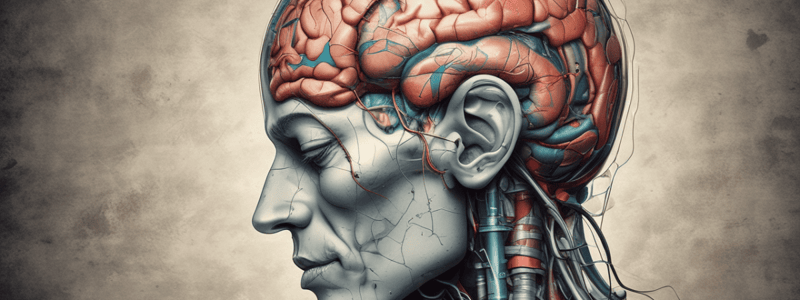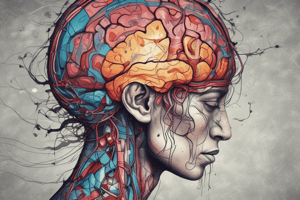Podcast
Questions and Answers
What is the primary indication for a CT scan in a patient with a head injury?
What is the primary indication for a CT scan in a patient with a head injury?
- Loss of consciousness
- Focal neurological deficits
- Skull fracture
- All of the above (correct)
What is the total Glasgow Coma Scale (GCS) score for a patient who is intubated, opens their eyes to pain, and briskly localizes?
What is the total Glasgow Coma Scale (GCS) score for a patient who is intubated, opens their eyes to pain, and briskly localizes?
- 7
- 6
- 8 (correct)
- 9
What is the primary limitation of a skull X-ray in the trauma setting?
What is the primary limitation of a skull X-ray in the trauma setting?
- It wastes time (correct)
- It is not indicated in patients with a GCS ≤ 14
- It is not sensitive for skull fractures
- It is not specific for skull fractures
What is an indication for observation at home in a patient with a head injury?
What is an indication for observation at home in a patient with a head injury?
What is a sign of a skull base fracture?
What is a sign of a skull base fracture?
What is the primary goal of autoregulation?
What is the primary goal of autoregulation?
What is the primary indication for cervical spine X-ray?
What is the primary indication for cervical spine X-ray?
What is the term for the point at which the intracranial pressure increases rapidly?
What is the term for the point at which the intracranial pressure increases rapidly?
What percentage of traumatic brain injuries are caused by transportation?
What percentage of traumatic brain injuries are caused by transportation?
What is the term for the disturbance of behavioral or emotional functioning resulting from traumatic brain injury?
What is the term for the disturbance of behavioral or emotional functioning resulting from traumatic brain injury?
What is the name of the doctrine that relates to the interplay between the brain, cerebrospinal fluid, and venous blood in the skull?
What is the name of the doctrine that relates to the interplay between the brain, cerebrospinal fluid, and venous blood in the skull?
What is the approximate annual mortality rate of children from road traffic accidents in South Africa?
What is the approximate annual mortality rate of children from road traffic accidents in South Africa?
What is the primary mechanism of traumatic brain injury?
What is the primary mechanism of traumatic brain injury?
What percentage of traumatic brain injuries are caused by firearms?
What percentage of traumatic brain injuries are caused by firearms?
What is the level of Glasgow Coma Scale associated with coma or severe head injury?
What is the level of Glasgow Coma Scale associated with coma or severe head injury?
What is the main goal of operative and non-operative strategies in managing head injuries?
What is the main goal of operative and non-operative strategies in managing head injuries?
What is the cutoff for hypoxia in terms of PO2?
What is the cutoff for hypoxia in terms of PO2?
What is the consequence of a single episode of hypotension in motorbike crashes?
What is the consequence of a single episode of hypotension in motorbike crashes?
What is the term for a patient who is awake but unaware of their surroundings?
What is the term for a patient who is awake but unaware of their surroundings?
What is the imaging study of choice in the acute assessment of head injury?
What is the imaging study of choice in the acute assessment of head injury?
What is a primary indication for re-admission in a patient with a head injury?
What is a primary indication for re-admission in a patient with a head injury?
What is the primary goal of preventing secondary brain injury?
What is the primary goal of preventing secondary brain injury?
What is the recommended glucose control in a patient with a head injury?
What is the recommended glucose control in a patient with a head injury?
What is the target cerebral perfusion pressure (CPP) in a patient with a head injury?
What is the target cerebral perfusion pressure (CPP) in a patient with a head injury?
What is the indication for ICP monitoring in a patient with a head injury?
What is the indication for ICP monitoring in a patient with a head injury?
What is the normal range of brain tissue oxygen tension (PbtO2) in a patient with a head injury?
What is the normal range of brain tissue oxygen tension (PbtO2) in a patient with a head injury?
What is the most important prognostic factor in a patient with a head injury?
What is the most important prognostic factor in a patient with a head injury?
What is the recommended head elevation in a patient with a head injury?
What is the recommended head elevation in a patient with a head injury?
Flashcards are hidden until you start studying
Study Notes
Head Injury
- Traumatic brain injury is an insult to the brain caused by an external physical force, resulting in a diminished or altered state of consciousness and impairment of cognitive abilities or physical functioning.
Anatomy
- Scalp
- Skull
- Brain
Epidemiology
- Transportation accounts for 44% of traumatic brain injuries
- Falls account for 26% of traumatic brain injuries
- Other causes include: • Firearms (8%) • Non-firearm assaults (9%) • Annual mortality of children from road traffic accidents is 3.89 per 100,000
Pathophysiology
- Primary vs secondary brain injury
- Monro-Kellie doctrine: the concept of a fixed volume of the cranial vault, where an increase in one component (blood, CSF, or brain tissue) leads to a decrease in another
Concepts
- Autoregulation
- Volume-pressure curve: • 60-55 mmHg: herniation • 50-40 mmHg: point of decompensation • 30-20 mmHg: compensation • 15-10 mmHg: volume of mass
Classification of Head Injury
- Glasgow Coma Scale (GCS): • Eye opening: 1-4 points • Verbal response: 1-5 points • Motor response: 1-6 points • Total GCS: 3-15 points
- Clinical scenario: a 20-year-old male in a motor vehicle accident, intubated, with a GCS score of 8
Approach to Head Injury
- History: • Mechanism of injury • Loss of consciousness • Vomiting • Seizures • Intoxicants • Post-traumatic amnesia
- Clinical examination: • Dilated non-reactive pupils • Hemiplegia/hemiparesis • Aphasia/dysphasia • Facial weakness • Cranial nerve palsy • Papilloedema
- Signs of skull base fracture: • Raccoon eyes • Battle sign
Investigations
- Skull X-ray: useful only for detecting skull fractures, but may waste time in the trauma setting
- CT scan:
• Indications:
- GCS ≤ 14
- Focal neurological deficits
- Deteriorating GCS
- Penetrating head injuries
- Post-traumatic seizures
- Loss of consciousness and amnesia
- Multiple trauma
- Skull fracture
- Patients who are intoxicated
- Patients on anti-coagulant therapy
- Mechanism of injury • Indications for observation at home:
- Normal CT
- GCS 15
- No focal deficits
- Easy access to ER
- Responsible adult to observe at home
- No complicating circumstances • Indications for re-admission:
- Drowsiness
- CSF leak
- Seizures
- New focal deficit
- Fever
Pathology
- Primary injury: • Acute extradural hematoma • Acute subdural hematoma • Contusion/intracerebral hematoma • Diffuse cerebral injury • Skull fracture • Gunshot injuries • Penetrating stab injuries • Concussion in sports • Non-accidental injury
- Secondary brain injury:
• Prevention: maintain Po2 > 60 mmHg, systolic BP > 90 mmHg, glucose control, and appropriate IV fluids
• Conservative management:
- GCS 13-15
- No focal deficits
- Neurological observations: ICU/high care (hourly) • Surgical management:
- ICU management:
- General measures:
- Head elevation 30 degrees
- Neck neutral position
- Urinary catheter
- Analgesia
- Gastro-protective agents
- Anti-seizure prophylaxis
- DVT prophylaxis
- Nutrition
- Fluids
- Medical management:
- Ventilation: PCo2 30-35 mmHg
- Sedation
- Mannitol
- Hypertonic saline
- General monitoring:
- ECG
- Saturations: 100%
- Systolic BP: > 90 mmHg
- Pulse
- Temperature: maintain euthermia or mild hypothermia
- CVP: 8-14 mmHg
- Glucose: normoglycemic
- ICP monitoring:
- Indications:
- GCS ≤ 8
- Polytrauma
- Prolonged ventilation
- Hypotension
- Posturing
- ICP > 20 mmHg: abnormal
- Indications:
- Brain tissue oxygen tension (PbtO2) monitoring:
- Normal values: 20-35 mmHg
- Cerebral perfusion pressure (CPP):
- CPP = MAP – ICP
- Targeted value: 60 mmHg
- Values < 50 mmHg: cerebral ischemia and hypo-perfusion
- Values > 70 mmHg: cardiorespiratory failure, ARDS
- General measures:
Prognostic Factors
- Age: younger patients have a greater potential for survival and recovery
- Mechanism of injury: e.g., motorbike crashes
- GCS < 8
- ICP > 45
- Hypotension: > 50% increase in mortality with a single episode of hypotension
- Hypoxia: PO2 < 60 mmHg, Sats < 90%
Glasgow Outcome Scale
- 1: Dead
- 2: Vegetative state
- 3: Severe disability
- 4: Moderate disability
- 5: Mild disability
Late Complications
- Post-traumatic seizures
- Hydrocephalus
- Infections
- Post-concussive syndrome: • Somatic: headaches, dizziness, anosmia, hearing difficulties, balance difficulties • Cognitive: difficulty concentrating, dementia, impaired judgment • Psychosocial: emotional problems, personality changes, loss of libido, tiredness, difficulty sleeping
Multidisciplinary Team
- Physiotherapists
- Occupational therapists
- Psychologists
- Social workers
- Nurses
- Doctors
Studying That Suits You
Use AI to generate personalized quizzes and flashcards to suit your learning preferences.




